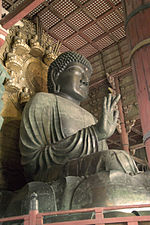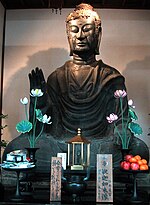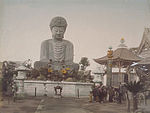Daibutsu: Perbedaan antara revisi
Tampilan
Konten dihapus Konten ditambahkan
←Membuat halaman berisi '{{nihongo|'''''Daibutsu'''''|大仏{{lang|en|; kyūjitai:}} 大佛}} atau 'Buddha raksasa' adalah istilah bahasa Jepang, sering digunakan secara...' |
Contoh |
||
| Baris 1: | Baris 1: | ||
{{nihongo|'''''Daibutsu'''''|大仏{{lang|en|; [[kyūjitai]]:}} 大佛}} atau 'Buddha raksasa' adalah [[bahasa Jepang|istilah bahasa Jepang]], sering digunakan secara informal, bagi [[patung Jepang|patung-patung]] [[Daftar Buddha|Buddha]]. Yang tertua adalah patung yang terdapat di [[Asuka-dera]] (609) dan yang paling terkenal{{fact|date=September 2015}} adalah yang terdapat di [[Tōdai-ji]] di [[Nara, Nara|Nara]] (752). ''Daibutsu'' Tōdai-ji' adalah bagian dari [[Situs Warisan Dunia |
{{nihongo|'''''Daibutsu'''''|大仏{{lang|en|; [[kyūjitai]]:}} 大佛}} atau 'Buddha raksasa' adalah [[bahasa Jepang|istilah bahasa Jepang]], sering digunakan secara informal, bagi [[patung Jepang|patung-patung]] [[Daftar Buddha|Buddha]]. Yang tertua adalah patung yang terdapat di [[Asuka-dera]] (609) dan yang paling terkenal{{fact|date=September 2015}} adalah yang terdapat di [[Tōdai-ji]] di [[Nara, Nara|Nara]] (752). ''Daibutsu'' Tōdai-ji' adalah bagian dari [[Daftar Situs Warisan Dunia di Jepang|Situs Warisan Dunia UNESCO]] [[Monumen Bersejarah Nara Kuno]] dan [[Khazanah Nasional Jepang|Khazanah Nasional]]. |
||
== Contoh == |
== Contoh == |
||
{| class="wikitable sortable" style="width:100%; background:#fff;" |
{| class="wikitable sortable" style="width:100%; background:#fff;" |
||
|- |
|- |
||
! style="text-align:left; width:8%; background:#ffdead;" class="unsortable"| |
! style="text-align:left; width:8%; background:#ffdead;" class="unsortable"|Citra |
||
! style="text-align:left; width:22%; background:#ffdead;"| |
! style="text-align:left; width:22%; background:#ffdead;"| Nama |
||
! style="text-align:left; width:8%; background:#ffdead;"| Buddha |
! style="text-align:left; width:8%; background:#ffdead;"| Buddha |
||
! style="text-align:left; width:10%; background:#ffdead;"| |
! style="text-align:left; width:10%; background:#ffdead;"| Ukuran |
||
! style="text-align:left; width:10%; background:#ffdead;"| |
! style="text-align:left; width:10%; background:#ffdead;"| Tanggal |
||
! style="text-align:left; width:10%; background:#ffdead;"| |
! style="text-align:left; width:10%; background:#ffdead;"| Munisipalitas |
||
! style="text-align:left; width:12%; background:#ffdead;"| |
! style="text-align:left; width:12%; background:#ffdead;"| Prefektur |
||
! style="text-align:left; width:20%; background:#ffdead;" class="unsortable"| |
! style="text-align:left; width:20%; background:#ffdead;" class="unsortable"| Komentar |
||
|- |
|- |
||
|[[ |
|[[Berkas:Shōwa Daibutsu.jpg|150px]]|| {{nihongo|[[Seiryū-ji|Shōwa Daibutsu]]|昭和大仏}}<ref>{{cite web |url=http://www.showa-daibutu.com/ |title=Shōwa Daibutsu |publisher=[[Seiryū-ji]] |accessdate=23 May 2011}}</ref> || || {{Convert|21.35|m|ft|1}} || 1984 || [[Aomori, Aomori|Aomori]] || [[Aomori Prefecture]] || |
||
|- |
|- |
||
| || {{nihongo|Ganmen Daibutsu|岩面大仏}}<!--reliable reference? images per google don't seem to agree; identified as [[Amida]] Butsu and commemorates the deaths of soldiers in two local wars in the 11th century. Originally it was a full Buddha seated in heaven but the body was destroyed in an earthquake in 1896. Takkoku no Iwaya Bishamondō: Visitor information pamphlet. Published by Betto Takkoku Seikōji, ph.(0191)46-4931 --> || || {{Convert|16.5|m|ft|1}} || || [[Hiraizumi]] || [[Iwate Prefecture]] || Low relief carving at {{nihongo|Takkoku no Iwaya|達谷窟}} |
| || {{nihongo|Ganmen Daibutsu|岩面大仏}}<!--reliable reference? images per google don't seem to agree; identified as [[Amida]] Butsu and commemorates the deaths of soldiers in two local wars in the 11th century. Originally it was a full Buddha seated in heaven but the body was destroyed in an earthquake in 1896. Takkoku no Iwaya Bishamondō: Visitor information pamphlet. Published by Betto Takkoku Seikōji, ph.(0191)46-4931 --> || || {{Convert|16.5|m|ft|1}} || || [[Hiraizumi]] || [[Iwate Prefecture]] || Low relief carving at {{nihongo|Takkoku no Iwaya|達谷窟}} |
||
|- |
|- |
||
| [[ |
| [[Berkas:Ushiku.jpg|150px]] || {{nihongo|[[Ushiku Daibutsu]]|牛久大仏}}<ref>{{cite web |url=http://www.ushikukankou.com/ushikudaibutsu_sugao.htm |title=Ushiku Daibutsu |publisher=[[Ushiku Daibutsu]] |accessdate=23 May 2011}}</ref> || [[Amida Nyorai]] || {{Convert|120|m|ft|1}} including base and [[Padma (attribute)|lotus]] ({{Convert|20|m|ft|1}}) || 1993 || [[Ushiku, Ibaraki|Ushiku]] || [[Ibaraki Prefecture]] || Japan's largest daibutsu |
||
|- |
|- |
||
| [[ |
| [[Berkas:Postcard Buddha.jpg|150px]] || {{nihongo|[[Nihon-ji]] Daibutsu|日本寺大仏}}<ref>{{cite web |url=http://www.nihonji.jp/revival/index.html |title=Nihonji Daibutsu |publisher=Nihon-ji |accessdate=23 May 2011}}</ref> || [[Yakushi Nyorai]] || {{Convert|31.05|m|ft|1}} || 1790 || [[Kyonan, Chiba|Kyonan]] || [[Chiba Prefecture]] || Carved in the 1780s and 90s by Jingoro Eirei Ono and his apprentices and restored to its present form in 1969. Japan's largest pre-modern (and largest stone-carved) daibutsu. The same site is also home to another large Buddha carving, the Hyakushaku Kannon{{Citation needed|date=May 2011}} |
||
|- |
|- |
||
| [[ |
| [[Berkas:Kamagaya-daibutsu.jpg|150px]] || {{nihongo|[[Kamagaya Great Buddha|Kamagaya Daibutsu]]|鎌ヶ谷大仏}} || || {{Convert|2.3|m|ft|1}}, including base ({{Convert|0.5|m|ft|1}}) || 1776 || [[Kamagaya, Chiba|Kamagaya]] || [[Chiba Prefecture]] || Japan's smallest daibutsu{{Citation needed|date=May 2011}} |
||
|- |
|- |
||
| [[ |
| [[Berkas:Ueno Daibutsu.JPG|150px]] || {{nihongo|Former [[Ueno Daibutsu]]|上野大仏}}<ref>{{cite news |url=http://www.yomiuri.co.jp/e-japan/siseki/20100413-OYT8T00589.htm |title=Ueno Daibutsu |work=[[Daily Yomiuri]] |date=30 March 2010 |accessdate=23 May 2011}}</ref> || [[Shaka Nyorai]] || || 1631 || [[Taitō, Tokyo|Taitō]] || [[Tokyo]] || Heavily damaged in the [[1923 Great Kantō earthquake]] and melted down for the [[Pacific War|war effort]] |
||
|- |
|- |
||
| [[ |
| [[Berkas:Tokyo daibutsu.JPG|150px]] || {{nihongo|Tokyo Daibutsu|東京大仏}}<ref>{{cite web |url=http://www.city.itabashi.tokyo.jp/c_kurashi/003/003913.html |title=Tokyo Daibutsu |publisher=[[Itabashi, Tokyo|Itabashi Ward]] |accessdate=23 May 2011}}</ref> || || {{Convert|13|m|ft|1}} including base || 1977 || [[Itabashi, Tokyo|Itabashi]] || [[Tokyo]] || Weighs thirty tons; at {{nihongo|Jōren-ji|乗蓮寺}}; erected in expiation of the [[1923 Great Kantō earthquake|Great Kantō earthquake]] and the [[Pacific War|war]] |
||
|- |
|- |
||
| [[ |
| [[Berkas:Kamakura Budda Daibutsu front 1885.jpg|150px]] || {{nihongo|[[Kōtoku-in|Kamakura Daibutsu]]|鎌倉大仏}}<ref>{{cite web |url=http://www.bunka.go.jp/bsys/maindetails.asp?register_id=201&item_id=270 |title=Database of National Cultural Properties |publisher=[[Agency for Cultural Affairs]] |accessdate=23 May 2011}}</ref> || [[Amida Nyorai]] || {{Convert|13.35|m|ft|1}} || 1252 || [[Kamakura, Kanagawa|Kamakura]] || [[Kanagawa Prefecture]] || Subject of the poem ''The Buddha at Kamakura'' by [[Rudyard Kipling]]; [[National Treasures of Japan|National Treasure]] |
||
|- |
|- |
||
| [[ |
| [[Berkas:Takaoka Daibutsu 2011-07-15 01.jpg|150px]] || {{nihongo|Takaoka Daibutsu|高岡大仏}} || [[Amida Nyorai]] || {{Convert|15.85|m|ft|1}} || 1981 || [[Takaoka, Toyama|Takaoka]] || [[Toyama Prefecture]] || At {{nihongo|Daibutsu-ji|大佛寺}} |
||
|- |
|- |
||
| [[ |
| [[Berkas:Echizen daibutsu 070203.jpg|150px|]] || {{nihongo|Echizen Daibutsu|越前大仏}}<ref>{{cite web|url=http://www.city.katsuyama.fukui.jp/english/english.html |title=Katsuyama Profile |publisher=[[Katsuyama, Fukui|Katsuyama City]] |accessdate=4 December 2007 |deadurl=yes |archiveurl=https://web.archive.org/web/20071007101616/http://www.city.katsuyama.fukui.jp/english/english.html |archivedate=7 October 2007 |df=dmy }}</ref> || || {{Convert|17|m|ft|1}} || || [[Katsuyama, Fukui|Katsuyama]] || [[Fukui Prefecture]] || |
||
|- |
|- |
||
| [[File:Gifugreatbuddha.jpg|150px]]|| {{nihongo|[[Gifu Great Buddha|Gifu Daibutsu]]|岐阜大仏}}<ref>{{cite web |url=http://www.gifu-daibutsu.com/shohoji/english.html |title=Gifu Shouhouji Daibutsu (Great Buddha) |publisher=[[Shōhō-ji (Gifu)|Shōhō-ji]] |accessdate=4 December 2007}}</ref> || [[Shaka Nyorai]] || {{Convert|13.63|m|ft|1}} || 1828 || [[Gifu, Gifu|Gifu]] || [[Gifu Prefecture]] || |
| [[File:Gifugreatbuddha.jpg|150px]]|| {{nihongo|[[Gifu Great Buddha|Gifu Daibutsu]]|岐阜大仏}}<ref>{{cite web |url=http://www.gifu-daibutsu.com/shohoji/english.html |title=Gifu Shouhouji Daibutsu (Great Buddha) |publisher=[[Shōhō-ji (Gifu)|Shōhō-ji]] |accessdate=4 December 2007}}</ref> || [[Shaka Nyorai]] || {{Convert|13.63|m|ft|1}} || 1828 || [[Gifu, Gifu|Gifu]] || [[Gifu Prefecture]] || |
||
|- |
|- |
||
| [[ |
| [[Berkas:Hōkōji Daibutsu Kaempfer.png|150px]] || {{nihongo|Former [[Hōkō-ji (Kyoto)|Hōkō-ji Daibutsu]]}} || || || 1660s || [[Kyoto]] || [[Kyoto Prefecture]] || Sketch of c.1691 by [[Engelbert Kaempfer]] |
||
|- |
|- |
||
| [[ |
| [[Berkas:NaraTodaijiDaibutsu0212.jpg|150px]] || {{nihongo|[[Tōdai-ji|Nara Daibutsu]]|奈良大仏}}<ref>{{cite web |url=http://www.bunka.go.jp/bsys/maindetails.asp?register_id=201&item_id=271 |title=Database of National Cultural Properties |publisher=[[Agency for Cultural Affairs]] |accessdate=23 May 2011}}</ref> || [[Vairocana]] || {{Convert|14.98|m|ft|1}} || 752 || [[Nara, Nara|Nara]] || [[Nara Prefecture]] || Restored several times; part of the [[World Heritage Sites in Japan|UNESCO World Heritage Site]]: [[Historic Monuments of Ancient Nara]]; [[National Treasures of Japan|National Treasure]] |
||
|- |
|- |
||
| [[ |
| [[Berkas:Asuka dera daibutsu.jpg|150px]] || {{nihongo|[[Asuka-dera|Asuka Daibutsu]]|飛鳥大仏}}<ref name=Sandaibutsu>{{cite web |url=http://www.aisf.or.jp/~jaanus/deta/s/sandaibutsu.htm |title=Sandaibutsu |publisher=[[Japanese Architecture and Art Net Users System]] |accessdate=23 May 2011}}</ref><ref>{{cite web |url=http://www.bunka.go.jp/bsys/maindetails.asp?register_id=201&item_id=4256 |title=Database of National Cultural Properties |publisher=[[Agency for Cultural Affairs]] |accessdate=23 May 2011}}</ref> || [[Shaka Nyorai]] || {{Convert|2.75|m|ft|1}} || 609 || [[Asuka, Nara|Asuka]] || [[Nara Prefecture]] || Japan's oldest daibutsu and Buddhist statue, restored; [[Important Cultural Properties of Japan|Important Cultural Property]] |
||
|- |
|- |
||
| [[ |
| [[Berkas:Hyogo Daibutsu.jpg|150px]] || {{nihongo|Former Hyōgo Daibutsu|兵庫大仏}}<ref>{{cite web |url=http://oldphoto.lb.nagasaki-u.ac.jp/en/target.php?id=1044 |title=Daibutsu Hyogo |publisher=Nagasaki University Library |accessdate=23 May 2011}}</ref> || || || 1891 || [[Kobe]] || [[Hyōgo Prefecture]] || At {{nihongo|[[Nōfuku-ji]]|能福寺}}; melted down in 1944 for the [[Pacific War|war effort]]{{Citation needed|date=May 2011}} and since replaced |
||
|- |
|- |
||
| [[ |
| [[Berkas:Reclining Buddha statues of Nanzoin.jpg|150px]] || ({{nihongo|[[Nanzoin temple|Nehanzo]] | 涅槃仏}}<ref name=Macleans>{{cite web|title=Karmic Cleansing|url=http://www.macleans.ca/society/life/karmic-cleansing/|website=Macleans.ca|accessdate=9 December 2015}}</ref> || [[Gautama Buddha]] || {{Convert|41|m|ft|1}} (length) ||1899|| [[Sasaguri, Fukuoka|Sasaguri]] || [[Fukuoka Prefecture]] || At [[Nanzoin temple|Nanzoin]] (南蔵院); contains ashes of [[Gautama Buddha|The Buddha]] and two of his disciples. |
||
|} |
|} |
||
Revisi per 20 September 2017 15.28
Daibutsu (大仏; kyūjitai: 大佛) atau 'Buddha raksasa' adalah istilah bahasa Jepang, sering digunakan secara informal, bagi patung-patung Buddha. Yang tertua adalah patung yang terdapat di Asuka-dera (609) dan yang paling terkenal[butuh rujukan] adalah yang terdapat di Tōdai-ji di Nara (752). Daibutsu Tōdai-ji' adalah bagian dari Situs Warisan Dunia UNESCO Monumen Bersejarah Nara Kuno dan Khazanah Nasional.
Contoh
| Citra | Nama | Buddha | Ukuran | Tanggal | Munisipalitas | Prefektur | Komentar |
|---|---|---|---|---|---|---|---|
| Berkas:Shōwa Daibutsu.jpg | Shōwa Daibutsu (昭和大仏)[1] | 2.135 meter (7.004,6 ft) | 1984 | Aomori | Aomori Prefecture | ||
| Ganmen Daibutsu (岩面大仏) | 165 meter (541,3 ft) | Hiraizumi | Iwate Prefecture | Low relief carving at Takkoku no Iwaya (達谷窟) | |||
| Berkas:Ushiku.jpg | Ushiku Daibutsu (牛久大仏)[2] | Amida Nyorai | 120 meter (393,7 ft) including base and lotus (20 meter (65,6 ft)) | 1993 | Ushiku | Ibaraki Prefecture | Japan's largest daibutsu |
 |
Nihon-ji Daibutsu (日本寺大仏)[3] | Yakushi Nyorai | 3.105 meter (10.187,0 ft) | 1790 | Kyonan | Chiba Prefecture | Carved in the 1780s and 90s by Jingoro Eirei Ono and his apprentices and restored to its present form in 1969. Japan's largest pre-modern (and largest stone-carved) daibutsu. The same site is also home to another large Buddha carving, the Hyakushaku Kannon[butuh rujukan] |
 |
Kamagaya Daibutsu (鎌ヶ谷大仏) | 23 meter (75,5 ft), including base (05 meter (16,4 ft)) | 1776 | Kamagaya | Chiba Prefecture | Japan's smallest daibutsu[butuh rujukan] | |
 |
Former Ueno Daibutsu (上野大仏)[4] | Shaka Nyorai | 1631 | Taitō | Tokyo | Heavily damaged in the 1923 Great Kantō earthquake and melted down for the war effort | |
| Berkas:Tokyo daibutsu.JPG | Tokyo Daibutsu (東京大仏)[5] | 13 meter (42,7 ft) including base | 1977 | Itabashi | Tokyo | Weighs thirty tons; at Jōren-ji (乗蓮寺); erected in expiation of the Great Kantō earthquake and the war | |
 |
Kamakura Daibutsu (鎌倉大仏)[6] | Amida Nyorai | 1.335 meter (4.379,9 ft) | 1252 | Kamakura | Kanagawa Prefecture | Subject of the poem The Buddha at Kamakura by Rudyard Kipling; National Treasure |
 |
Takaoka Daibutsu (高岡大仏) | Amida Nyorai | 1.585 meter (5.200,1 ft) | 1981 | Takaoka | Toyama Prefecture | At Daibutsu-ji (大佛寺) |
| Berkas:Echizen daibutsu 070203.jpg | Echizen Daibutsu (越前大仏)[7] | 17 meter (55,8 ft) | Katsuyama | Fukui Prefecture | |||
 |
Gifu Daibutsu (岐阜大仏)[8] | Shaka Nyorai | 1.363 meter (4.471,8 ft) | 1828 | Gifu | Gifu Prefecture | |
 |
error: {{nihongo}}: Butuh teks Jepang atau romaji (bantuan) | 1660s | Kyoto | Kyoto Prefecture | Sketch of c.1691 by Engelbert Kaempfer | ||
 |
Nara Daibutsu (奈良大仏)[9] | Vairocana | 1.498 meter (4.914,7 ft) | 752 | Nara | Nara Prefecture | Restored several times; part of the UNESCO World Heritage Site: Historic Monuments of Ancient Nara; National Treasure |
 |
Asuka Daibutsu (飛鳥大仏)[10][11] | Shaka Nyorai | 275 meter (902,2 ft) | 609 | Asuka | Nara Prefecture | Japan's oldest daibutsu and Buddhist statue, restored; Important Cultural Property |
 |
Former Hyōgo Daibutsu (兵庫大仏)[12] | 1891 | Kobe | Hyōgo Prefecture | At Nōfuku-ji (能福寺); melted down in 1944 for the war effort[butuh rujukan] and since replaced | ||
| Berkas:Reclining Buddha statues of Nanzoin.jpg | (Nehanzo (涅槃仏)[13] | Gautama Buddha | 41 meter (134,5 ft) (length) | 1899 | Sasaguri | Fukuoka Prefecture | At Nanzoin (南蔵院); contains ashes of The Buddha and two of his disciples. |
Referensi
- ^ "Shōwa Daibutsu". Seiryū-ji. Diakses tanggal 23 May 2011.
- ^ "Ushiku Daibutsu". Ushiku Daibutsu. Diakses tanggal 23 May 2011.
- ^ "Nihonji Daibutsu". Nihon-ji. Diakses tanggal 23 May 2011.
- ^ "Ueno Daibutsu". Daily Yomiuri. 30 March 2010. Diakses tanggal 23 May 2011.
- ^ "Tokyo Daibutsu". Itabashi Ward. Diakses tanggal 23 May 2011.
- ^ "Database of National Cultural Properties". Agency for Cultural Affairs. Diakses tanggal 23 May 2011.
- ^ "Katsuyama Profile". Katsuyama City. Diarsipkan dari versi asli tanggal 7 October 2007. Diakses tanggal 4 December 2007.
- ^ "Gifu Shouhouji Daibutsu (Great Buddha)". Shōhō-ji. Diakses tanggal 4 December 2007.
- ^ "Database of National Cultural Properties". Agency for Cultural Affairs. Diakses tanggal 23 May 2011.
- ^ "Sandaibutsu". Japanese Architecture and Art Net Users System. Diakses tanggal 23 May 2011.
- ^ "Database of National Cultural Properties". Agency for Cultural Affairs. Diakses tanggal 23 May 2011.
- ^ "Daibutsu Hyogo". Nagasaki University Library. Diakses tanggal 23 May 2011.
- ^ "Karmic Cleansing". Macleans.ca. Diakses tanggal 9 December 2015.
Pranala luar
Wikimedia Commons memiliki media mengenai Buddha statues in Japan.
